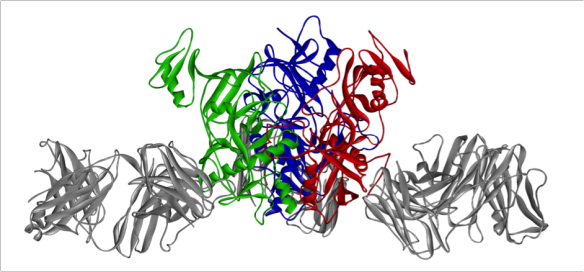A Crystal Structure That Was Only Possible With the Help of an Ebola Survivor
What does it look like?

Ebola glycoprotein (in blue, green and red) in complex with Fab KZ52 (in grey)
What is it?
The Ebola virus has been in the news recently due to the ongoing outbreak in West Africa. Ebola virus causes Ebola haemorrhagic fever with a mortality rate of 50 to 90%. Symptoms of Ebola haemorrhagic fever consist of flu-like symptoms such as headaches, fever, and joint and muscle pain. Those infected with Ebola can also suffer multiple organ failure and bleeding with death occurring 6 to 9 days after symptoms appearing. There is currently no vaccine against the Ebola virus.
Ebola virus is a single stranded, negative-sense RNA virus from the Filoviridae family. The Ebola virus genome codes for only eight proteins. One of the genes codes for glycoprotein (GP) which is the structure shown today. GP has two subunits: GP1 and GP2. GP1 effects attachment of the Ebola virus to the infected host cells and GP2 mediates the fusion of the virus and host membranes. Due to GP's importance to the Ebola virus' ability to infect cells it is a good target for drugs and vaccines.
The GP structure shown is the trimeric (each monomer coloured blue, green and red) pre-fusion conformation. Each monomer assembles to form a structure that resembles a chalice. One of the hardest parts of structural biology is obtaining the crystals of proteins. One way to grow crystals of difficult proteins is to co-crystallise the protein bound to an antibody that is specific for the protein of interest. This is what was done in this work. The grey structures are Fab fragments (the part of the antibody that binds the protein) from the antibody KZ52. How KZ52 was obtained is very complex and beyond the scope of this blog (details can be found here), but without the donation of bone marrow from a patient who survived an Ebola infection from an outbreak in 1995 in Kikwit, Democratic Republic of Congo, we would probably still not know the structure of this protein.
Where does it come from?
The structure of GP in complex with KZ52 was solved by Jeffery Lee and colleagues at The Scripps Institute at La Jolla, California [1]. This structure was taken from the Protein Data Bank (PDB number: 3CSY).
[1] J. E. Lee, M. L. Fusco, A. J. Hessell, W. B. Oswald, D. R. Burton, E. Ollmann Saphire (2008) Structure of the Ebola virus glycoprotein bound to an antibody from a human survivor Nature 454: 177-182.






